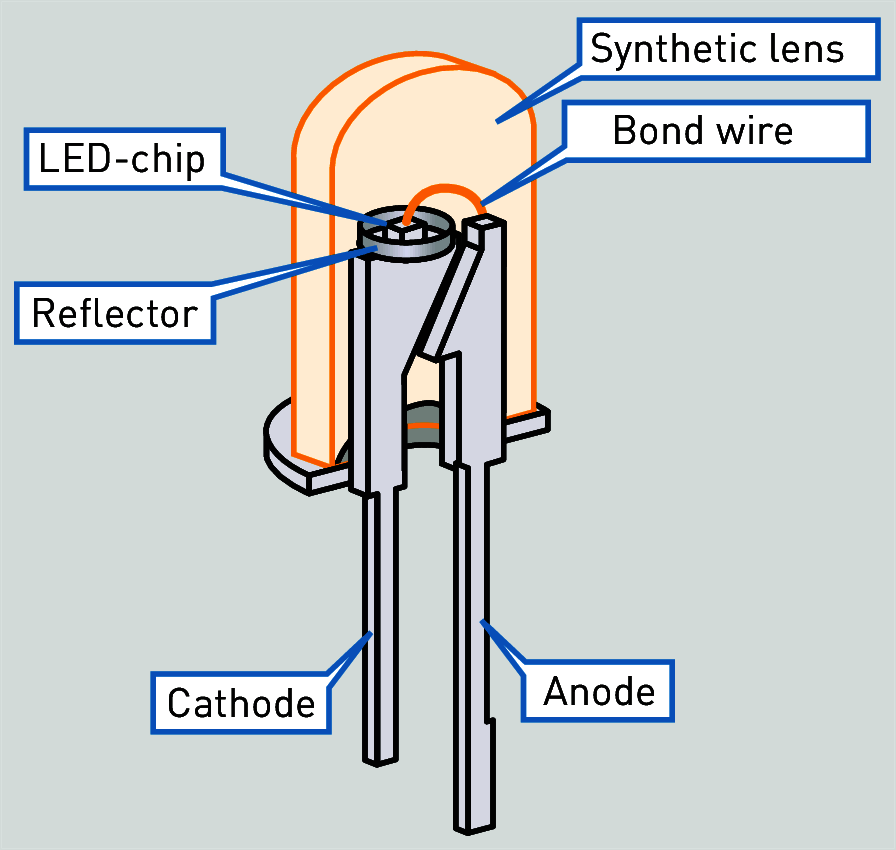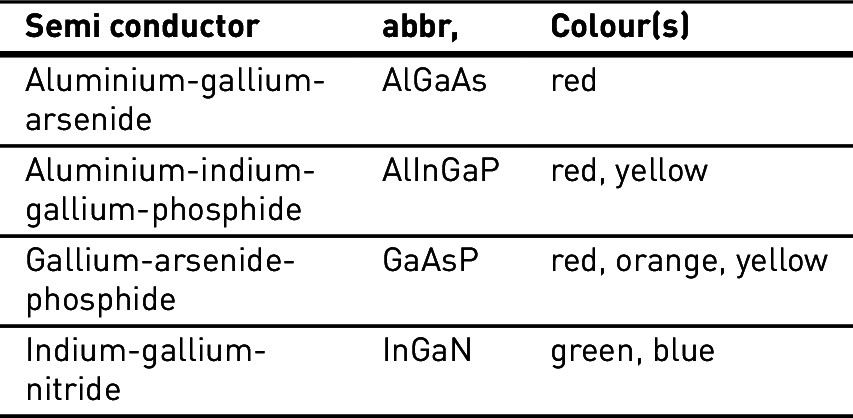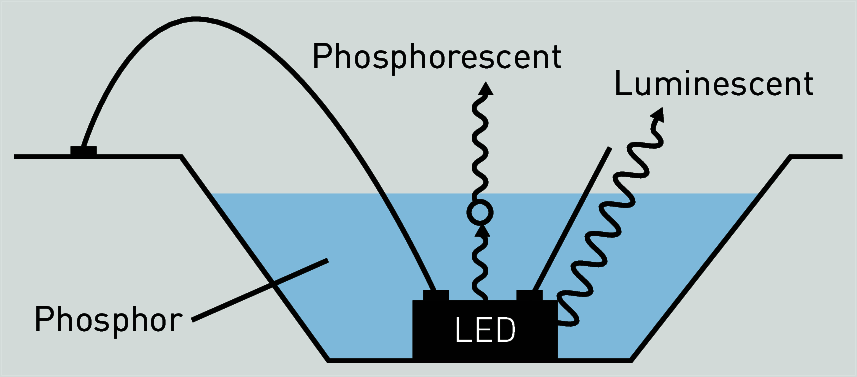
(a) Schematic construction of an LED
Postbox 1960
D-59753 Arnsberg

(a) Schematic construction of an LED

(b) Materials for generating coloured LED light
Figure 3.250: The LED
Light generation in an LED (light-emitting diode) takes place in a very small range of the p-n-junction of the crystalline, semi-conductive material where a part of the released energy is converted into light (electroluminescence) during recombination of positive and negative charge carriers. This generates monochromatic light of a specific colour (yellow, orange, red, green, blue) or wavelength. The generated light is narrow-bandwidth and material-specific (see table in figure b). A reflector and lens with different visual properties (gathering, scattering etc.) improve light emission.
White light is generated either by mixing red, yellow and blue LED (RGB) or by coating a blue LED with a fluorescent substance which partially converts the LED’s blue light into light of the green or red spectral range.
RGB mixing is currently hardly used in general lighting applications. On one hand, neither colour rendering, expressed by the colour rendering index Ra, nor luminous efficacy of the white light generated by RGB mixing is satisfactory. On the other hand, its chromaticity coordinates change over time due to the different degradation of the individual colour LEDs (see chapter ). However, RGB colour mixing has a broad use spectrum in decorative and well-being applications (see also chapter 3.3.1), signalling equipment (e.g. in motor vehicles, traffic light installations) and for guidance systems (in buildings or outdoor spaces).
In contrast, the conversion of blue LED light through fluorescent coating is a procedure used wherever great amounts of high-quality white light are required. For example in for residential lighting, work place lighting and road lighting. High colour stability, good to excellent colour rendering properties as well as very high luminous efficacies are characteristics of this method.
Regarding luminous efficacy, values exceeding 200 lm/W are measured in the laboratory. However, these lamp luminous flux figures cannot be used as technical data since the luminous efficacy is highly dependent on specific luminaire operating conditions. LED power supply as well as thermal management (see chapter ) are important factors here which are closely related to the expected service life of the luminaire.
Regarding residential lighting, so-called “retrofit” lamps with LED technology are widely used today. These are integrated systems consisting of LEDs and electronic components (see chapter 5.8.4) required for their operation (see chapter ), often featuring E27 or E14 sockets for replacing the former general-use incandescent lamp.
Retrofit lamps are rarely used in work place lighting. The reason is that luminaires in work places, in contrast to individual household luminaires, are generally operated in larger groups as lighting installations with long operating times. This leads to higher economic and safety-related requirements (see also chapter 5.6.1 “Luminaire labelling, type plate”) regarding:
energy efficiency of the luminaire,
service life of the lamp/luminaire
photometric characteristics of the lamp/luminaire for photometric planning,
electromagnetic compatibility
power factor (avoiding blind current), and
avoidance of flicker.
Today, LED luminaires as optimised complete systems with built-in LED light sources and electronics fulfil these requirements much better.
LED light sources are dimmed using different methods. A common method is pulse-width modulation (PWM) where, according to an adjustable ON/OFF ratio, direct current generated by the control gear unit is turned on and off, thereby regulating the energy input. In contrast to dimming via trailing-edge phase cutting in incandescent lamps, where the light of the slowly cooling filament is not extinguished, the LED follows the pulse-width-modulation practically without delay. For applications where stroboscopic effects would be disturbing, PWM dimming should be avoided. There are no physiological effects on persons at PWM frequencies above 400 Hz. Switching with smaller PWM frequencies should not be applied. To this end, appropriate control gear units (see chapter ) are required, e.g. with DALI interface (see chapter ).
Further developments regarding the usage of electroluminescence concern organic LEDs, so-called OLED, where light is generated in an organic substance. While crystalline LED are very small single elements with a diameter of just a few millimetres, OLED can be used in particular to produce planar light emitters. Currently, they are used predominantly in display technology. An economic usage of OLED in general lighting is not expected to become reality for now.

Figure 3.251: White LED